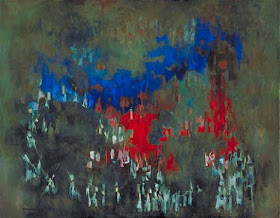Sam Gilliam, The Petition, 1990, mixed media
Smithsonian American Art Museum's exhibition, African American Art: Harlem Renaissance, the Civil Rights Era and Beyond gives a broad overview of 43 artists whose work spanned 8 decades of the 20th century. Over 40 photographs, as well as paintings, give a provocative picture of urban and rural life during the Depression, the age of segregation and the Civil Rights and later. Although there is some overlap with other 20th century art movements, the exhibition is mainly art focused on African-Americans and their lives. Both abstract and figural paintings are included, but also sculpture by Richard Hunt, Sam Gilliam, an important recent figure in the art scene of Washington, DC. The artists come from the South and North, with a large number from urban areas of Detroit, New York, St. Louis, Baltimore and Washington, DC.
Detroit artist Tony Gleaton recorded his travels to Nicaraguain in Family of the Sea, 1988, from the series Tengo Casi 500 Anos: Africa's Legacy in Central America, above. Roy De Carava was a New Yorker whose photos capture aspects of city life as in Two Women Manikan's Hand, 1950, printed 1982, on right. (gelatin silver prints)
The portraits give impressive concentrated views of individual personalities, particularly by Tony Gleaton and Earlie Hudnall, Jr. I especially liked the photographs of Ray DeCarava, for the artistic compositions with interesting value contrasts. Although the portrait photography is very interesting, I'm partial to DeCarava's staged compositions which look like film stills.
Ray DeCarava, Lingerie, New York, 1950, printed 1982, gelatin silver print, left.
Gleaton's works are part of series photos, such as Africa's legacy in Central America. But there is also a series from the WPA (Works Project Administration of the 1930s, part of the New Deal. Robert McNeill 's several photographs include those from his project entitled, The Negro in Virginia which has both interesting portraits and slices of life. The art of photojournalism really began at this time, during the 1930s.
The contrast of black and white photography works well exhibited next to bold, colorful works of art by the Harlem Renaissance artists, such as Jacob Lawrence and Romare Bearden, who worked with collages. Bearden, Lawrence, as well as Lois Mailou Jones and Norman Lewis, are among the most important painters who contributed to the artistic life of Harlem in the 20s and 30s. The Harlem Renaissance also produced writers, musicians and poets such as Langston Hughes.
Community, by Jacob Lawrence is a gouache of 1986.
It is a study for the mural of the same name in Jamaica, New York
Charles Searles' Celebration is an acrylic study for a mural painting
in the William H Green Building, Philadelphia, made in 1975
Charles Searles was from Philadelphia and the Smithsonian's Celebration is actually a study for a mural done in the William H Green Federal Building in Philadelphia. Likewise, Community is a study for a mural Lawrence did in Jamaica, New York, 1986. It evokes a spirit of togetherness and cooperation.
Norman Lewis, Evening Rendezvous, 1962
Abstract works may actually be visualizations with other meanings. Norman Lewis's Evening Rendezvous of 1962, is an abstract medley of red white and blue, but the white refers to hoods of the KluKluxKlan and red to fires and burnings. Not all is innocent fun, but Enchanted Rider, done by Bob Thompson in 1961 is more optimistic. The rider may actually be a vision of St. George who triumphed over evil and is a traditional symbol of Christian art.Enchanted Rider by Bob Thompson, 1961
Lois Mailou Jones, Moon Masque, 1971









This comment has been removed by a blog administrator.
ReplyDelete